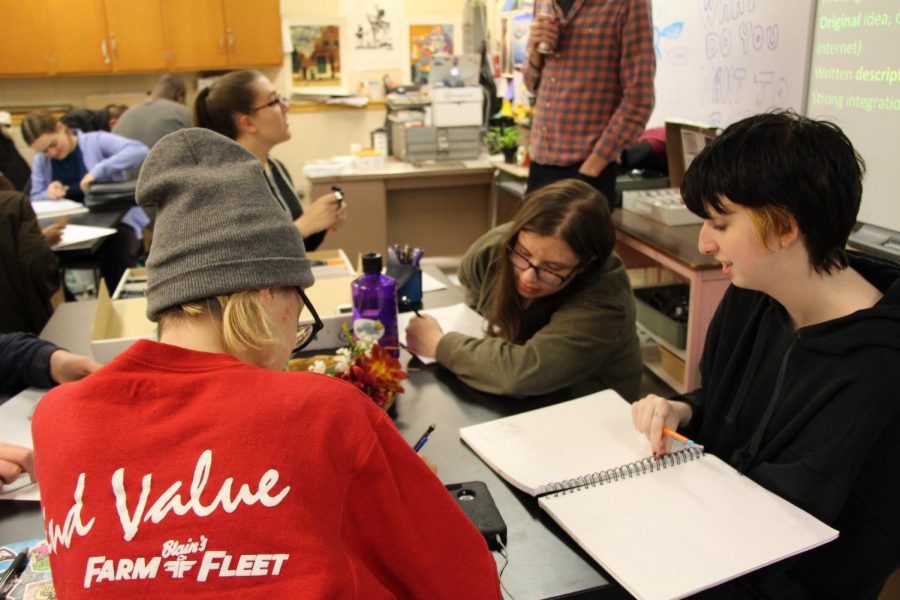Can art classes limit artists?
Rose Opstad, Red Gustafson and Catherine Matejcek are all in different classes and each have a different perspective on the grading system. The way their Art is graded has a different on each of them ranging from indifference to a belief that large changes must be made.
December 5, 2017
Drawing and painting are limitless art forms that leave room for the imagination of young creators to run wild and potentially build a career. Naturally there are classes at south dedicated to helping young artists hone their craft. However, the way assignments in art classes are graded can make students feel limited in their expression. So how can someone grade art for its objective value? Through a rubric or through the effort put in?
Rubrics are one of the most common ways to grade art however this grading process can sometimes be a problem for students. Audrey Janz is a sophomore in Cynthia Berger’s AP Studio art class explained how the grading process for her work “It gets based off of a rubric. The rubric goes through analyzation for each teacher but a rubric usually.” This can limit her creativity. “With rubrics there’s barriers and there’s certain things that maybe are looked down upon and those things are important too. If you wanted purposeful ghost marks like eraser marks or anything and you could get docked points because you have those eraser marks”.
Rose Opstad is a senior in Thomas Willicombe’s Drawing 1 class. She described the way her work was graded. “We fill out self evaluations, so we’ll learn how to do a new technique.” Often times students in this class will focus one technique for an extended period of time, learning different variations of the technique culminating in them ultimately creating a project for their grade.
Opstad went on to further describe the assignment and how it was graded. “In this one we have to have a perspective drawing and a full gray scale so from white to black as shading and coloring in for the drawing and then at the end of the unit what we do is we are given self evaluation rubric”.
While rubrics are common in an art class Opstad discussed how hers was unique.¨We’re graded on things like our craftsmanship and how well we used gray scale and stuff like that and then we get asked ‘ok what do you like about your artwork? If you could restart your artwork what would you do differently and what are two challenges that you have overcome while doing this artwork’ so you fill those in yourself and then we get graded by our peers too.”
Thomas Willicombe has been an art teacher at South for 3 years described how he grades projects and how it isn’t always consistent saying it “depends on the assignment, for projects they get graded on a number of things including but not limited to certain criteria each project needs such as certain craftsmanship issues as well as targets that pertain to the project itself.
Willicombe continued explaining; “It’s like having a certain amount of patterns or things that have to do with each assignment but they’re all kinda lifted out so it’s not subjective at all and it’s based upon reachable goals for whatever the project is.”
However the grading process can sometimes be a problem for students. Janz explained how the grading process for her work “It gets based off of a rubric. The rubric goes through analyzation for each teacher but a rubric usually.” This can limit her creativity. “With rubrics there’s barriers and there’s certain things that maybe are looked down upon and those things are important too. If you wanted purposeful ghost marks like eraser marks or anything and you could get docked points because you have those eraser marks”
Janz added how she felt that if you put restrictions on what an artist was allowed to do it defeated the purpose of art ¨I think that if you give a limit to something that’s all about the limitless it would be like putting a damper on your creativity.¨ Janz added a simile that she felt described her situation. ¨You can burn birchwood when it’s wet right? It’s like drowning the birchwood while you’re on fire.”
Willicombe described the type of projects he gives and avoids the problem of grades being subjective. “People always say that art is subjective but it depends on the type of art. If were trying to draw an apple and make it look realistic generally that’s an objective thing to see, how realistic your apple turns out.¨
Willicombe described the issues he had faced grading different genres of art ¨If you’re trying to talk about modern art or abstract art then it can get a little more messy but for the most part, especially once you understand the language of art as far as the elements and principles of design and a lot of things that go into art like composition it’s really easy to look at, let’s say, a photograph”.
“It’s easy to know if it was shot well or it wasn’t shot well, there’s a lot of things that kinda help boil that down if you know what you’re talking about. If you don’t know what you’re talking about or don’t know a lot about art then it’s certainly gonna seem more subjective because you don’t really understand what it takes to make a good piece of art but it’s much more technical then you would think.¨
Willicombe added that the way he grades art can avoid problems of viewing a piece subjectively .¨[The rubric has] simple things you can hit. For example if we’re looking at this perspective project we’re doing right now generally with linear perspective it’s either right or it’s not as far as following the correct guidelines so having it drawn accurately in perspective is worth a lot of points, making sure that you’re filling up the entire piece of paper with drawing is important not leaving any blank spaces, making sure that you have a foreground, middle ground, background. All those things are easily hit and you can make sure ‘I’ve got that. Oh I’ve got that. Oh I’ve got that’ So I can’t be like ‘Oh I don’t think this is good.’ and then grade it bad as long as you’re hitting that.”
Red Gustafson is another sophomore in Berger’s AP Studio Art class. While they also have issues with the grading system they have a bit of sympathy for it. “for the last quarter we did breadth assignments which is showing you can do more than one thing or whatever and oh my god there were so many limitations to what we could and could not do and things that the teacher doesn’t want us to do which I respect because she’s the teacher…and she knows what [the college board] wants but it’s kinda hard to do this class if you don’t do what you like to do.” AP Studio art students are encouraged to appeal to the College Board that is responsible for their portfolio and if they get an art scholarship.
Janz expressed similar frustrations. “Well when you give certain specifications I mean you can definitely fit your artwork to those things but if there is just a basic limit to things most of the time it’s just kinda like ‘Oh well what if I wanted to expand this off the page or I wanted to make this warm toned instead of cool’ and certain materials are required. I personally hate charcoal paint and I hate using it but sometimes you are required to use it and it’s not the best.”
It is clear that some students despite using different grading systems can still feel limited by how their art is graded and how projects are assigned. The quality of art is something that is difficult for teachers to measure between each individual student. Art classes are important but it is equally important that students feel that they are doing art the way they want to and that teachers are fully understanding their work.







